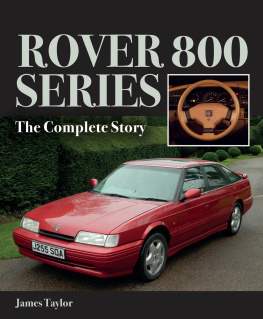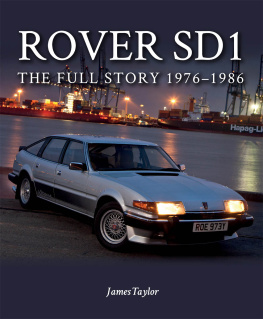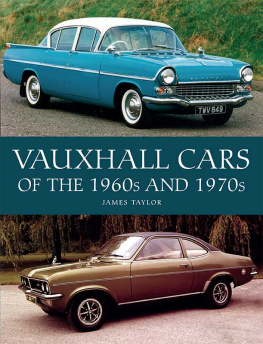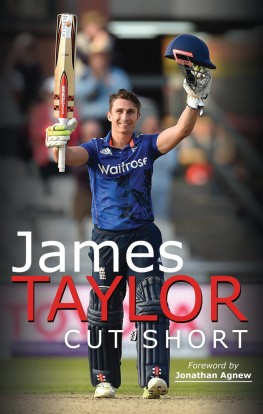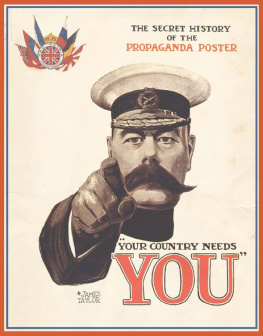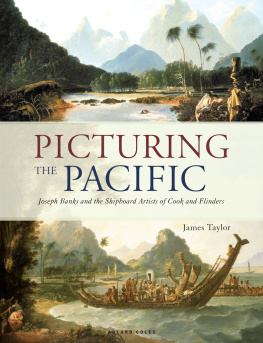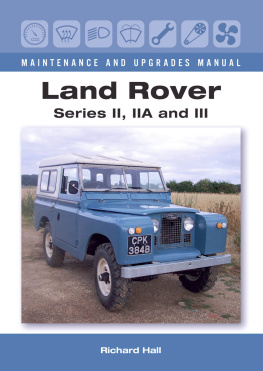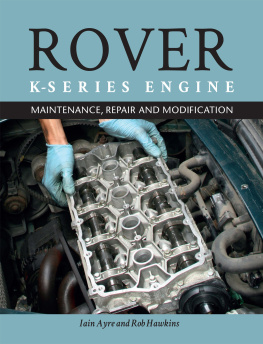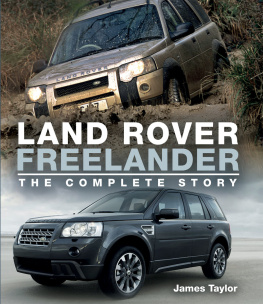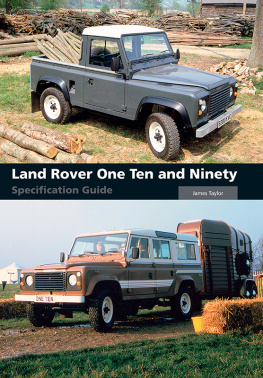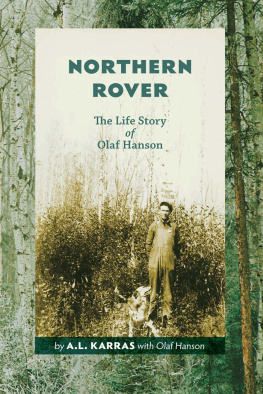ROVER 800
SERIES
The Complete Story
OTHER TITLES IN THE CROWOOD AUTOCLASSICS SERIES
ALFA ROMEO 916 GTV AND SPIDER Robert Foskett
ALFA ROMEO SPIDER John Tipler
ASTON MARTIN DB4, DB5 & DB6 Jonathan Wood
ASTON MARTIN DB7 Andrew Noakes
ASTON MARTIN V8 William Presland
AUDI QUATTRO Laurence Meredith
AUSTIN HEALEY Graham Robson
BMW 5 SERIES James Taylor
BMW M3 James Taylor
BMW M5 James Taylor
BMW CLASSIC COUPS James Taylor
CITRON DS SERIES John Pressnell
FERRARI 308, 328 AND 348 Robert Foskett
FORD CONSUL, ZEPHYR AND ZODIAC Graham Robson
FORD ESCORT RS Graham Robson
FROGEYE SPRITE John Baggott
JAGUAR E-TYPE Jonathan Wood
JAGUAR XK8 Graham Robson
JENSEN INTERCEPTOR John Tipler
JOWETT JAVELIN AND JUPITER Geoff McAuley & Edmund Nankivell
LAMBORGHINI COUNTACH Peter Dron
LAND ROVER DEFENDER, 90 AND 110 RANGE James Taylor
LOTUS ELAN Matthew Vale
MGA David G. Styles
MGB Brian Laban
MGF AND TF David Knowles
MGT-SERIES Graham Robson
MAZDA MX-5 Antony Ingram
MERCEDES-BENZ CARS OF THE 1990s James Taylor
MERCEDES-BENZ FINTAIL MODELS Brian Long
MERCEDES-BENZ S-CLASS James Taylor
MERCEDES-BENZ W124 James Taylor
MERCEDES SL SERIES Andrew Noakes
MERCEDES W113 Myles Kornblatt
MORGAN 4/4 Michael Palmer
MORGAN THREE-WHEELER Peter Miller
PEUGEOT 205 Adam Sloman
PORSCHE 924, 928, 944 AND 968 Glen Smale
PORSCHE CARRERA THE AIR-COOLED ERA Johnny Tipler
RELIANT THREE-WHEELERS John Wilson-Hall
RILEY RM John Price-Williams
ROVER 75 AND MG ZT James Taylor
ROVER P4 James Taylor
ROVER P5 & P5B James Taylor
SAAB 99 & 900 Lance Cole
SUBARU IMPREZA WRX AND WRX STI James Taylor
SUNBEAM ALPINE AND TIGER Graham Robson
TOYO TA MR2 Nigel Burton
TRIUMPH SPITFIRE & GT6 Richard Dredge
TRIUMPH TR7 David Knowles
VOLKSWAGEN GOLF GTI James Richardson
VOLVO P1800 David G. Styles
ROVER 800
SERIES
The Complete Story
James Taylor

THE CROWOOD PRESS
First published in 2016 by
The Crowood Press Ltd
Ramsbury, Marlborough
Wiltshire SN8 2HR
www.crowood.com
This e-book first published in 2016
James Taylor 2016
All rights reserved. No part of this publication may be reproduced or transmitted in any form or by any means, electronic or mechanical, including photocopy, recording, or any information storage and retrieval system, without permission in writing from the publishers.
British Library Cataloguing-in-Publication Data
A catalogue record for this book is available from the British Library.
ISBN 978 1 78500 225 0
CONTENTS

INTRODUCTION AND ACKNOWLEDGEMENTS
The Rover 800 was more of a milestone in the car industry than most people realize. It was the largest and most comprehensive joint project ever undertaken by two companies that were not only independent but also geographically and culturally separated by a vast divide. That it was any kind of success is certainly a tribute to the dedication of the engineers at Rover in Britain and at Honda in Japan who worked on it.
Was it a success? On Rovers side, it provided them with a large car that they badly needed and could not afford to design and manufacture on their own. It taught them new manufacturing disciplines and edged them towards the quality that had been lost during the British Leyland years of the 1970s. That it never sold in quite the anticipated numbers was mostly not the cars fault although the bad reputation that British Leyland had attracted still lingered to some extent and must have deterred many buyers. On Hondas side, it provided them with their first large car and gave them valuable experience of both the European and American large-car markets. The Japanese company has never looked back.
The 800 Series has taken a long time to become an enthusiasts car, but I was delighted to discover just as this book was in the final stages of preparation that it was to have its own formal club. The Rover 800 Owners Club was officially launched at the NEC Classic Motor Show in November 2015, and I wish it every success.
In putting this book together, I drew on the vast collection of material in my own archive, amassed since the 800 was new in 1986. I can still remember trying out an 825i demonstrator over the summer of that year, one of the Cxxx AAC registered cars, and being encouraged to see how fast it would go on the M4 motorway. I needed no encouragement, and a nervous salesman suggested that we should keep a sharp look out for police cars when the speedo nudged 115mph. So I backed off. I didnt buy the car, either, and will admit now that I was never a fan of the early 800. Once the Fastback became available, though, and then the facelifted cars in 1991, my view changed to one of keen interest.
I was pleased to be able to draw to a limited extent on the archives of the British Motor Museum at Gaydon (formerly British Motor Industry Heritage Trust), although surviving records of Rover 800 production are far from complete. I hope that more hard information comes to light in the future. I also drew on the collections and recollections of many others, most of whom may well not even remember passing on vital information all those years ago. Special thanks, though, go to the following: Richard Bryant, long-term friend and long-term enthusiast for Rover cars of all ages (and an 800 Sterling KV 6 owner himself); Paddy Carpenter of the Police Vehicle Enthusiasts Club; Sally Eastwood, whose recollection of the end of the US Sterling operation is recorded in ; Ian Elliott, formerly involved with PR and marketing at Austin Rover; Tanya Field, who kindly provided her 1991 820 Turbo for photography (she was lucky I gave it back); David Morgan, researcher and great enthusiast for Austin Rover cars; and Ron and Pam Winchester, for the loan of their Japanese-spec Coup while I was in New Zealand.
James Taylor
Oxfordshire
November 2015

FOREWORD
by John Bacchus, formerly Director in charge of the Rover-Honda relationship
In the mid-1970s, I was Strategic Planning Director for BL International. Id been watching Honda for some time; I found them fascinating because their US performance was astonishing. They had come from nowhere and now a Honda franchise was the absolute prize in the USA. They were also very advanced in their design as compared with their Japanese counterparts.
When Michael Edwardes took over, we quickly realized that collaboration was the way forward. This was unheardof in the industry, at least among the major players, even though it has since become common. A sensible choice at the time looked like an alliance with Chrysler Europe, who were being supported by the government just as we were. Then, before we made an approach, Chrysler was sold to PSA Peugeot-Citroen! Honda was our choice as a replacement collaborator.
Next page
